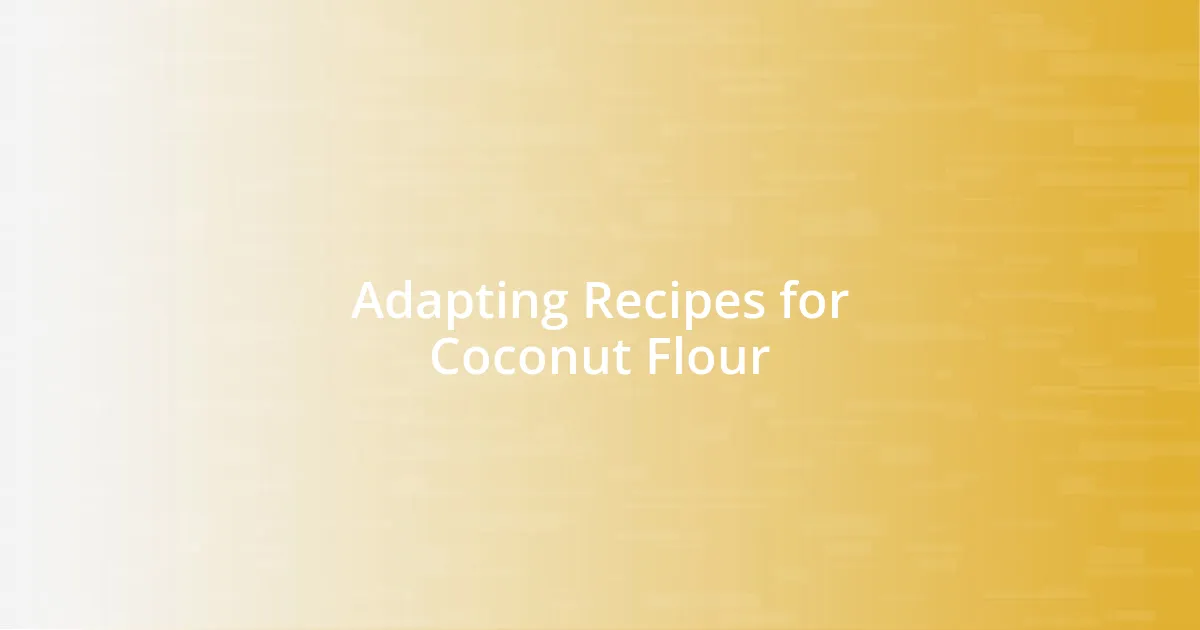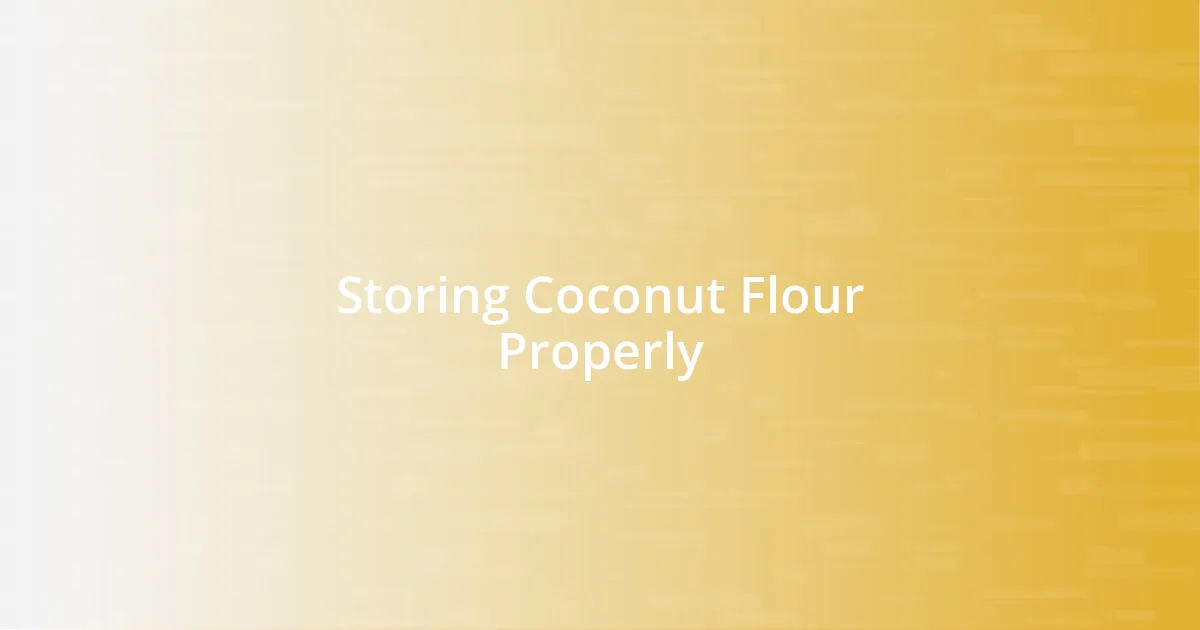Key takeaways:
- Coconut flour is high in fiber, gluten-free, and enhances the flavor of baked goods.
- When substituting coconut flour for all-purpose flour, use 1/4 to 1/3 cup of coconut flour per cup of all-purpose flour and adjust liquids accordingly.
- Proper storage in an airtight container in a cool, dark place or refrigerating/freezing can extend coconut flour’s freshness.
- Coconut flour can be creatively used beyond baking, such as a thickening agent for sauces, in smoothies, and for making energy bites.

Understanding Coconut Flour Benefits
Coconut flour is often celebrated for its high fiber content, which I found to be a game-changer in my baking adventures. When I switched from all-purpose flour to coconut flour, I noticed a significant difference in how satisfied I felt after eating. That fullness comes from the amazing fiber that not only aids digestion but also helps in maintaining steady blood sugar levels. Isn’t it fascinating how a simple change in our flour choice can impact our overall health?
Another benefit I discovered is that coconut flour is naturally gluten-free. This realization was quite liberating for me, as I have friends with gluten sensitivities who often feel left out during baking sessions. I remember hosting a small get-together and making gluten-free coconut flour pancakes. Everyone loved them, and to my surprise, even those without dietary restrictions couldn’t get enough! Have you ever tried cooking for friends with specific dietary needs? It feels rewarding when you can cater to everyone.
Lastly, the subtle flavor of coconut flour adds a unique twist to baked goods that I absolutely adore. My first experience with banana coconut muffins left me pleasantly surprised at how the coconut enriched the taste without overpowering it. It’s incredible how one ingredient can elevate a dish’s flavor profile. Have you ever thought about how certain ingredients can bring out the best in others? That’s exactly what coconut flour did for my baking!

Finding the Right Coconut Flour
Finding the right coconut flour can be a bit of a journey. I remember the first time I tried to locate the perfect brand, feeling a mix of excitement and trepidation. There are various types of coconut flour available, and it can be confusing at times, especially with brands boasting different textures and flavors. The key is to look for coconut flour that is finely ground and free from additives, as this greatly impacts the texture of your baked goods.
When selecting coconut flour, consider these essential factors:
- Texture: Aim for a fine, powdery texture for a smoother baking experience.
- Color: Opt for flour that appears bright white—this usually indicates freshness.
- Source: Look for organic brands; they often have higher quality and fewer pesticides.
- Packaging: Check for resealable bags to maintain freshness after opening.
- Nutritional Information: Review fiber content; higher fiber usually leads to better health benefits.
I’ll never forget how delighted I felt when I finally discovered a local brand that checked all these boxes. It made such a difference in my baking! It was like unlocking a new level in a game—I couldn’t wait to experiment with all those recipes in my kitchen!

Adapting Recipes for Coconut Flour
Adapting recipes for coconut flour can be a bit of a trial-and-error process, but I found it incredibly rewarding. Initially, I stumbled while trying to convert an old family recipe for chocolate chip cookies. I quickly learned that coconut flour behaves differently; it absorbs a lot more moisture than traditional flour. For instance, I figured out that for every cup of coconut flour, you need to reduce the amount of flour in the original recipe by about 1/4 to 1/3 while increasing liquids or eggs accordingly. The result was a chewy texture that kept everyone coming back for more!
What really surprised me was how coconut flour impacts the overall flavor of my baked goods. My first attempt at a carrot cake using coconut flour resulted in a delightful surprise. It wasn’t just the texture that changed; the coconut flavor added depth that was simply divine. I remember slicing into that cake and feeling thrilled as I watched my family enjoy it, their eyes lighting up at the unexpected twist. Have you ever had a baking moment that felt transformative? This was definitely one of those for me.
I also discovered that due to its high fiber content, I often needed to adjust the amount of sugar in my recipes. I remember trying to bake a coconut flour bread that originally called for a hefty amount of sugar. After tasting the batter, I realized it was too sweet with the coconut flour absorbing flavors differently. A little experimentation led me to cut down on the sugar and enhance the natural sweetness of the other ingredients. It taught me to be more attuned to the balance of flavors, which is something I now appreciate in all my baking adventures.
| Original Recipe Ingredient | Adapted Coconut Flour Ingredient |
|---|---|
| 1 cup all-purpose flour | 1/4 to 1/3 cup coconut flour |
| 1 egg | 1 egg (may need an extra egg due to moisture) |
| 1 cup liquid (milk, water) | 1 – 1.5 cups liquid |
| 1 cup sugar | Reduce by 25% or adjust based on taste |

Common Mistakes to Avoid
One of the biggest mistakes I made when baking with coconut flour was underestimating its moisture-absorbing properties. The first time I baked brownies, I followed the original recipe and ended up with a dry, crumbly mess. It was a learning moment when I realized that I needed to add extra liquids—more eggs or milk—just like how we sometimes need a little more patience in life. Have you ever had a recipe turn out completely different from what you expected? That moment really taught me to adjust my mentality as well as my measurements.
Another common pitfall to watch out for is using too much coconut flour. I fell into this trap when I thought increasing the amount would make my baked goods even tastier. Instead, I was left with dense, overly fibrous muffins that were far from enjoyable. It’s essential to remember that coconut flour is not a 1:1 substitute. In my experience, sticking to those guidelines of replacing all-purpose flour with just 1/4 to 1/3 of coconut flour made all the difference. This taught me that moderation counts, both in cooking and in life.
Finally, don’t forget to sift your coconut flour if it clumps together, just like how we sift through our thoughts to find clarity. I didn’t realize this on my first attempt at pancakes and ended up with gritty textures. Now, I always make it a point to sift, which creates a smoother batter and ultimately enhances the flavor experience. Have you tried sifting? It’s become a small yet meaningful ritual in my baking routine, turning what could be a simple task into a thoughtful practice.

Storing Coconut Flour Properly
When it comes to storing coconut flour, ensuring its freshness is key to maintaining its unique flavor and texture. I’ve found that transferring it to an airtight container makes a world of difference. The first time I left coconut flour in its original packaging, I could taste a distinct deterioration after just a couple of weeks. Have you ever tasted something that just didn’t have the same zest as before? That’s exactly how I felt—like I was missing out on the rich coconut essence.
It’s also crucial to keep coconut flour in a cool, dark place, as light and heat can degrade its quality. I learned this the hard way; I once stored it near my oven, thinking it wouldn’t make much difference. Boy, was I wrong! I opened my container months later to find a stale product that lacked the freshness I had once loved. Now, I always place it in a cupboard far from heat sources, ensuring longevity and flavor.
For those who bake infrequently, consider refrigerating or even freezing coconut flour. This tip came from a friend who took her baking seriously. I decided to give it a shot and was delighted to discover it stayed fresh for months at a time. It really opened my eyes to how little changes in storage can lead to surprisingly positive results. Have you thought about your storage habits? A simple adjustment might just elevate your baking experience!

Creative Uses for Coconut Flour
I’ve discovered some really exciting uses for coconut flour that go beyond traditional baking. One surprising application is using it as a thickening agent for sauces and soups. I remember making a curry one evening, and instead of relying solely on cornstarch, I added a tablespoon of coconut flour. Not only did it give the dish the right consistency, but it added a subtle sweetness that took the flavor profile to another level. Have you ever tried experimenting with a thickener that surprises you?
Then there’s the idea of incorporating coconut flour into smoothies. I started adding a scoop to my morning blend, and it transformed my breakfast routine. The flour not only boosted the nutritional value but also provided a delightful creaminess. Who would’ve thought that a simple ingredient could enhance both taste and texture? It’s a sneaky way to sneak in some extra fiber and make your smoothie more satisfying.
Lastly, I’ve found that coconut flour works wonders in making homemade energy bites. Mixing it with nut butter, honey, and a few chocolate chips has become my go-to snack. The coconut flour binds everything beautifully and adds a rich flavor. It’s incredible how such a versatile ingredient can create quick and healthy treats that are perfect for busy days. Have you explored these creative avenues with coconut flour yet? I bet you’d be surprised by the delightful outcomes!













